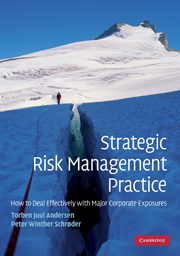Book contents
- Frontmatter
- Contents
- List of abbreviations
- List of figures
- List of tables
- List of boxes
- Preface
- 1 The strategic nature of corporate risk management
- 2 Economic exposures in corporate risk management
- 3 Managing market-related business exposures
- 4 Extending the risk management perspective
- 5 Integrative risk management perspectives
- 6 Current risk management practice and the rise of ERM
- 7 Strategic risk analyses
- 8 Strategic risk management – amendments to the ERM framework
- 9 Strategic risk management
- 10 Postscriptum
- Appendices
- Appendix 1 A strategic responsiveness model
- Appendix 2 Determining the premium on a call option
- Appendix 3 Determining the value of a real option
- Index
- References
7 - Strategic risk analyses
Published online by Cambridge University Press: 05 June 2012
- Frontmatter
- Contents
- List of abbreviations
- List of figures
- List of tables
- List of boxes
- Preface
- 1 The strategic nature of corporate risk management
- 2 Economic exposures in corporate risk management
- 3 Managing market-related business exposures
- 4 Extending the risk management perspective
- 5 Integrative risk management perspectives
- 6 Current risk management practice and the rise of ERM
- 7 Strategic risk analyses
- 8 Strategic risk management – amendments to the ERM framework
- 9 Strategic risk management
- 10 Postscriptum
- Appendices
- Appendix 1 A strategic responsiveness model
- Appendix 2 Determining the premium on a call option
- Appendix 3 Determining the value of a real option
- Index
- References
Summary
This chapter will discuss a variety of analytical tools that may be adopted for risk management purposes. Initially, common tools applicable to analyze trends and emerging issues within predictable and known business environments are put forward, and a resemblance to strategic management is revealed through examples. Uncertainty is added to the spectrum, and the use of templates such as scenario planning and real options is outlined. It is shown how these approaches may enable the corporation to evaluate the effect of a changing risk landscape and to take necessary precautionary measures. Environmental uncertainty affects the corporation and introduces unexpected events that can cause major deviations to plans. The relevance of contingency planning is discussed and it is argued that it may work in simple and predictable environments to handle more severe deviations. However, it is subsequently argued that it must be complemented by a culture of mindfulness known from high reliability organizations in more complex and unpredictable environments. The chapter is rounded off with a discussion of risk management under unknowable environmental conditions as it must deal with ‘unk unks’. The role of values, behaviour and corporate culture in dealing with uncertainty and unforeseeable events is considered.
Environmental scanning in a predictable world
Corporations often face environmental changes that seem to come out of thin air. The previous chapter suggested that nearly 90 per cent of the drops in shareholder value can be attributed to strategic and operational risk events.
- Type
- Chapter
- Information
- Strategic Risk Management PracticeHow to Deal Effectively with Major Corporate Exposures, pp. 146 - 177Publisher: Cambridge University PressPrint publication year: 2010



